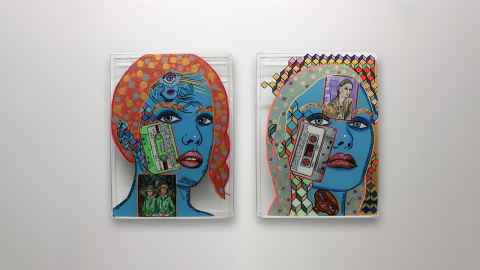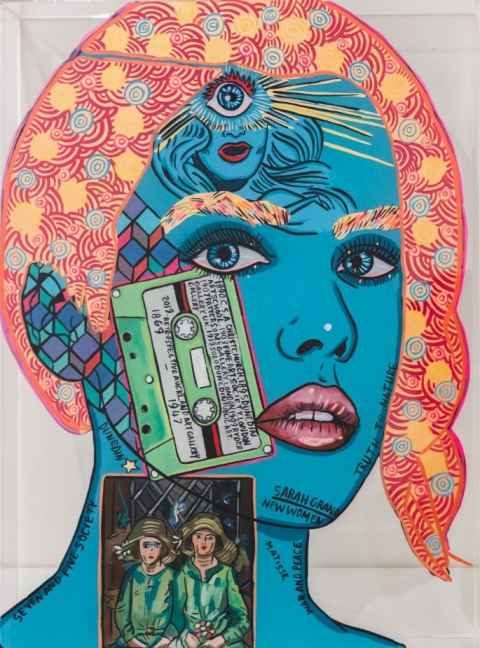Sam Mitchell artworks highlight female creativity and achievement
1 July 2023
Sam Mitchell’s paintings are a far cry from the traditional oil portraits that spring to mind when one thinks of the portraiture genre.

There is no mistaking a Sam Mitchell painting. Each is bold, electrifyingly vibrant and incorporates a distinctive iconology that is recognisable to art enthusiasts and consumers of culture alike.
A keen eye might also recognise some of the historic figures that are represented in her portraits; from celebrated artists and novelists like Octavia Butler, to historic figures like Catherine the Great. However, Sam’s paintings are a far cry from the traditional oil portraits that spring to mind when one thinks of the portraiture genre. Her unique works are layered, in more ways than one.
Sam Mitchell (b. 1971) is an alumnus of Elam School of Fine Arts, having graduated in 2000 with a Bachelor of Fine Arts. Since then, she has exhibited widely across Aotearoa New Zealand and the United States. Throughout her career she has experimented with acrylic and watercolour painting, ink drawing, collage and ceramics. She has particularly refined her technique of painting with acrylic onto perspex; a medium that has become characteristic of her practice.
Painting on perspex is a painstaking method, as the subject must be painted both backwards and in reverse. This means that the smallest details (such as the subjects’ eyelashes and the fine outlines of smaller objects) are painted first, with multiple layers added on top and the background colours (creating skin, or hair) being applied last. Sam describes these paintings as “portraits from the inside out,” emulating the ancient reverse glass painting technique that flourished in cities across Asia and Europe from as early as the 13th century.
Understanding the complexity of this method is vital to appreciating the fine detail and exceptional control in Sam’s works. She typically uses a perspex box with an open back as her ‘canvas’, meaning that the resulting paintings have a three-dimensional quality and are contained underneath their glossy front veneer.
A pair of Sam’s paintings done in this manner are part of the University of Auckland Art Collection. Frances Hodgkins (2019) and Olivia Spencer Bower (2019) were acquired in early-2020, following the artist’s solo exhibition Endlings (Bartley and Company Art, 2019).

Sam often chooses the subjects of her paintings using a feminist lens, through which she highlights female creativity and achievement. The Endlings series depicted a group of celebrated women artists and writers from around the world, including the likes of Margaret Mahy and Alice Neel. Both Frances Hodgkins and Olivia Spencer Bower were created in an extension of this series. The paintings represent their titled subjects; two renowned female painters from local art history in Aotearoa New Zealand.
However, Sam’s portraits aren’t literal. The subjects are identifiable mostly through the symbolic imagery that she overlays on their faces and torsos, not dissimilar to tattoos on their distinctive blue skin. Olivia Spencer Bower was a celebrated watercolour painter who was a member of The Group; an influential collective of artists, including Rita Angus and Louise Henderson, that formed in reaction to the conservatism of national art institutions around the 1930s. In Olivia Spencer Bower, Sam has incorporated a rendering of Spencer Bower’s own Self-portrait (1950) that is held in the Christchurch Art Gallery Te Puna o Waiwhetū collection.
Similarly, in Frances Hodgkins, Sam places a reproduction of notable artist Frances Hodgkins’ painting Bridesmaids (1930) on the figure’s neck. Hodgkins is widely regarded as one of Aotearoa New Zealand’s most important expatriate painters and was the subject of major retrospective Frances Hodgkins: European Journeys, held at Auckland Art Gallery Toi o Tāmaki in 2019. By including depictions of such distinctive works from each artists’ oeuvre, Sam visually signals their identities.
Notably, in this body of work, Sam incorporates a cassette tape in each portrait. As explained in the exhibition text accompanying Endlings, “each cassette tape provides an historical positioning on the women’s lives in the 20th century pre-digital era, and a deliberate playing with ideas about the recording of history.”
In both paintings, the incorporated cassette tapes are inscribed with something of a brief biography for the titled subject. For example, the cassette in Olivia Spencer Bower includes the line “1940 Elam School of Fine Art,” signifying the five years that Spencer Bower taught at Elam.
Casting a technical eye over both portraits, one notes that the tiny cassette tape texts would have been the very first layer of what would become striking portraits. Through her method, it seems that Sam refocuses our attention on the lives and achievements of the women she depicts, intentionally inside-out.
The University of Auckland Art Collection comprises close to 2,000 artworks and is well regarded for including work by many of New Zealand’s best-known and most-loved artists. The collection is a valuable cultural asset shared across campuses and luckily for us, it’s permanently on display.
By Madeleine Gifford
This story first appeared in the July 2023 edition of UniNews.